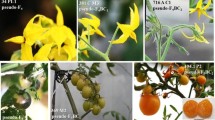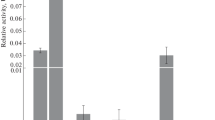Abstract
Studies on tomato culture revealed for the first time two phenomena: (1) instability of gene gs (green stripes on fruits) and (2) spontaneous expression of the character determined by the gs gene without involvement of sexual reproduction in some cultivars. The instability of the gs gene was detected by the phenotypic expression of character in different plants from the same strain, racemes of the same plant, fruits of the same raceme, and parts of the same fruit. The instability of the gsgene may be determined by endogenous regulatory genetic elements causing specific changes of the character, with the degree of these changes varying for different parts of the fruit and places of its formation on the plant. The instability of the gs gene was expressed for four generations. There were no other phenotypic changes in the offsprings studied. In addition, migration of the recessive gs gene to other cultivars followed by its complete expression in a whole plant or some parts of the plant was observed. Exogenous transfer of thegsgene is suggested.
Similar content being viewed by others
REFERENCES
Rick, C.M., Mutschler, M., and Tanskley, D., Linkage Maps of the Tomato (Licopersicon esculentum), Rep. Tomato Gen. Cooper., 1987, no. 37, pp. 5-34.
Genetika kul'turnykh rastenii: zernobobovye ovoshch-nye, bakhchevye (Crop Genetics: Grain Legumes, Vegetables, Melons, and Pumpkins), Fadeeva, T.S. and Burenin, V.I., Leningrad: Agropromizdat, 1990, pp. 164-214.
Khesin, R.B., Nepostoyanstvo genoma (Genome Instability), Moscow: Nauka, 1985.
Alikhanyan, S.I., Akif'ev, A.P., and Chernin, L.S., Obshchaya genetika (General Genetics), Moscow: Vysshaya Shkola, 1985, pp. 320-326.
Dubinin, N.P., Obshchaya genetika (General Genetics), Moscow: Nauka, 1986, 3rd ed., p. 232.
Genetika kul'turnykh rastenii: kukuruza, ris, proso, oves (Crop Genetics: Maize, Rice, French Wheat, Oat), Dorofeev, V.F., Fadeeva, T.S., and Shmaraev, G.E., Eds., Leningrad: Agropromizdat, 1988, pp. 6-104.
Aiala, F. and Kaiger, D., Sovremennaya genetika (Modern Genetics), Moscow: Mir, 1988, vol. 2, pp. 158-162.
Berzile, F., Lassner, M., Tong, R., et al., Sexual Transmission of a Transposed Activator Element in Transgenic Tomatoes, Genetics, 1989, no. 123, pp. 181-189.
Avdeyev, Y.I. and Kigashpaeva, O.P., Jumping Tomato Gene gs, Rep. Tomato Gen. Cooper., 2000, no. 50, pp. 9-11.
Avdeyev, Y.I. and Scherbinin, B.M., High Susceptibility of Fruit to Colletotrichum phomoides (Sacc) Chest in gs/gs Lines, Rep. Tomato Gen. Cooper., 1997, no. 47, pp. 8-9.
Kirai, Z., Klement, Z., Shoimoshi, F., and Veresh, I., Metody fitopatologii (Methods in Phytopathology), Moscow: Kolos, 1974.
Finnegan, D.J., Transposable Elements and DNA Transposition in Eukaryotes, Curr. Opin. Cell Biol., 1990, vol. 2, pp. 471-477.
Arkhipova, I.R., Lyubomirskaya, N.V., and Ilyin, Y.V., Drosophila Retrotransposons, in Molecular Biology, Intelligence Unit, Austin, Tex.: Langes, 1995, p. 131.
Garlinkel, D.J., Boeke, J.D., and Fink, G.R., Ty Element Transposition: Reverse Transcriptase and Virus-like Particles, Cell (Cambridge, Mass.), 1985, vol. 42, pp. 507-517.
Gorelova, T.V., Resnick, N.L., and Schuppe, N.G., Retrotransposon Transposition Intermediates Are Encapsidated into Virus-like Particles, FEBS. Lett., 1988, vol. 244, no. 2, pp. 307-310.
Reznik, N.L., Kidgotko, O.V., Zolotova, L.I., and Shuppe, N.G., Heterologous Indication of Tu1 Transposition: Reverse Transcription Plays a Key Role in Triggering the Retrotransposition Cycle, Genetika (Moscow), 1995, vol. 31, no. 12, pp. 1605-1613.
Andrianov, B.V. and Shuppe, N.G., Tv1, a New Family of Drosophila virilis Retrotransposons, Genetika (Moscow), 1994, vol. 30, no. 4, pp. 437-444.
Zolotova, L.I., Andrianov, B.V., Gorelova, T.V., et al., Polymorphism of Retrotransposon Virus-like Particles in Drosophila and Yeast Cells, Genetika (Moscow), 1996, vol. 32, no. 11, pp. 1528-1535.
Song, S.U., Gerasimova, T., Kurkulos, M., et al., An Env-like Protein Encoded by a Drosophila Retroelement: Evidence That gypsy in an Infectious Retrovirus, Genet. Dev., N.Y.: Cold Harbor Lab., 1994, vol. 8, pp. 2046-2057.
Lee, S., Mao, L., Main, D., et al., A Tomato Sequence-Tagged Connector (STC) Database, Rep. Tomato Gen. Cooper., 2000, no. 50, pp. 26-27.
Author information
Authors and Affiliations
Rights and permissions
About this article
Cite this article
Avdeev, Y.I., Kigashpaeva, O.P. Jumping Gene gs of Lycopersicon lycopersicum (L.) Karsten ex Farw. Russian Journal of Genetics 38, 496–500 (2002). https://doi.org/10.1023/A:1015530928409
Issue Date:
DOI: https://doi.org/10.1023/A:1015530928409




